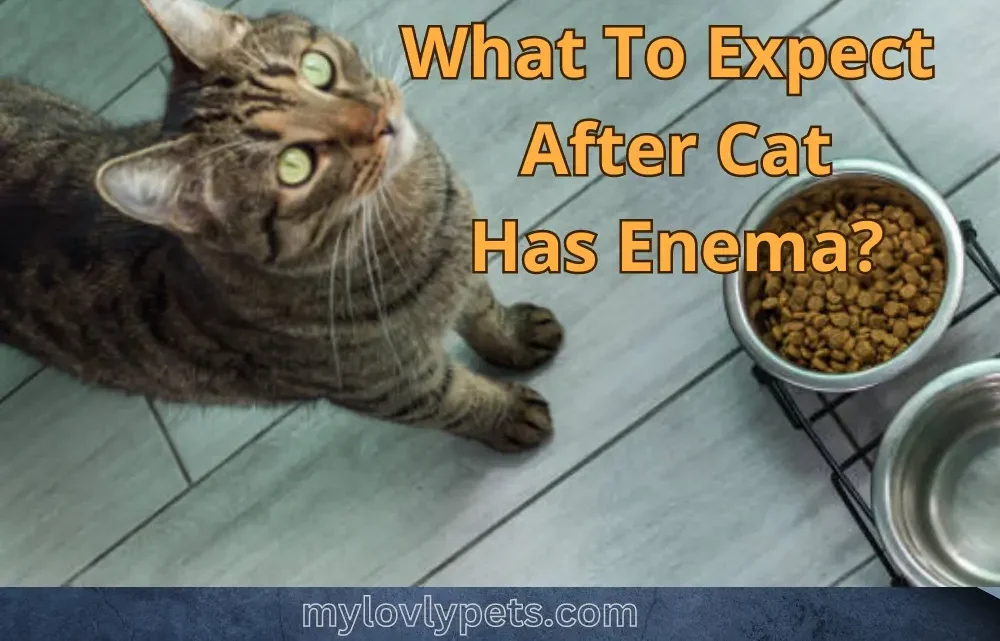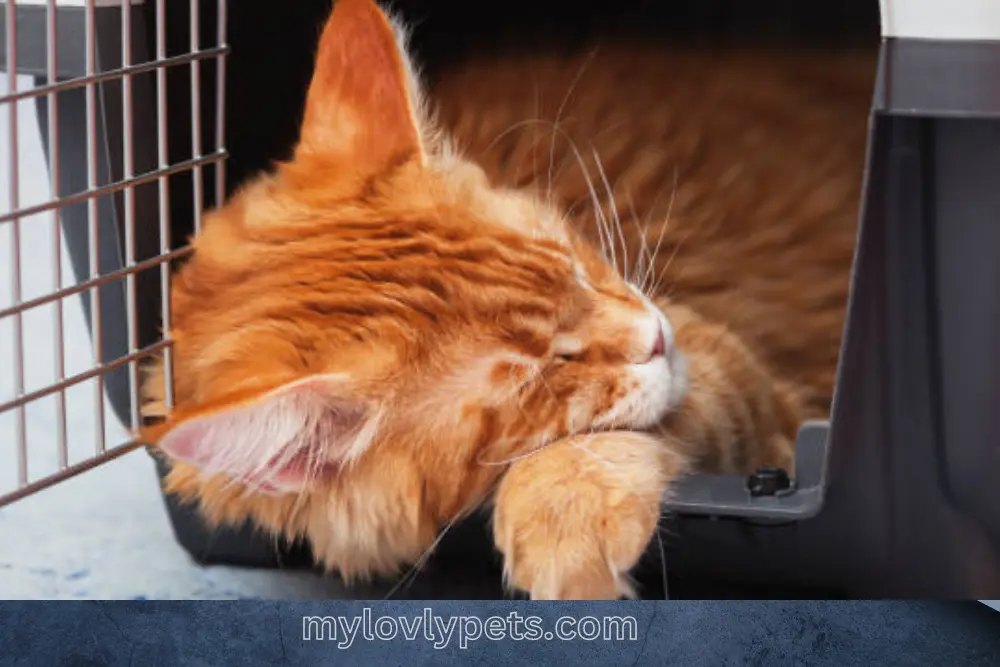
What To Expect After Cat Has Enema? (Potential Side Effects)
Constipation is a common problem in cats, prompting owners to consider enemas a quick remedy. It’s best to consider cat enemas as a last resort rather than a first option. Using repeated enemas to treat cat constipation is not recommended.
Enema procedures for cats are usually safe and painless. However, they may leave the cat feeling sensitive and not quite like themselves afterward. Vomiting can occur after an enema, despite efforts to prevent it.
What to expect after cat has enema? Understanding the side effects of a cat enema is crucial for your pet’s well-being and recovery. In this post, we will provide cat owners with a comprehensive guide on managing the immediate cat enema side effects and offer tips for long-term care and providing comfort and support to their feline companions.
What is An Enema Procedure For a Pet?
A veterinary enema assists constipated cats without a bowel movement for a few days. Enema is a procedure where a saline solution or laxative is inserted into the rectum to stimulate bowel movements.
Enemas are crucial for cats who have ingested harmful substances. This procedure can help cats with constipation and improve their digestion.
Why Give a Cat an Enema?
Administering a cat enema involves injecting fluid into the rectum to stimulate bowel movements. Cats are often given enemas when constipated to prevent health risks associated with constipation.
Common causes of constipation in cats include inadequate water intake, a poor diet, or underlying health conditions. If your cat is constipated, an enema can usually help. However, if the problem persists, it’s best to consult a vet. Olive oil can help relieve constipation in cats.
What to expect after cat has enema?– Cat Enema Side Effects
Administering an enema to your cat may appear daunting, but rest assured, it is a swift and secure process. Following an enema, your cat may encounter side effects, including loose stool, vomiting, temporary diarrhea, increased aloofness, and reduced appetite.
Loose Stool
After the procedure, it’s common for cats to experience runny stool or brown liquid discharge from their anus. Your cat may take some time to resume regular bowel movements, so ensure you have paper towels or pet diapers ready for the journey home.
Vomiting
Vomiting from an enema’s impact on your cat’s digestive system is standard and typically not problematic. You must notify your vet if your pet continues vomiting for over 24 hours.
Temporary diarrhea
Short-term diarrhea is a common side effect after using an enema or taking laxatives. Your cat’s litter box may be busier than usual for a day or two as it eliminates built-up waste. If your dog has diarrhea for more than a few days, it’s essential to consult your vet. Prolonged diarrhea can be harmful.
Increased Aloofness
After visiting the vet, your cat might feel antisocial and grumpy. It’s essential to give them some space to decompress.

Reduced Appetite
It’s common for cats to lose their appetite after an enema, especially if they previously experienced severe constipation. Their appetite will typically return to normal within a day or two. You must notify your vet if your cat’s appetite doesn’t improve within a few days. A prolonged lack of eating can result in liver failure.
Although enemas may cause temporary side effects, they are essential for helping your cat eliminate waste and enhance their overall well-being.
How Long Does a Cat Enema Take to Work?
It’s best to have a bowel movement right after the procedure for cats and enemas. However, that’s not always true. If your cat hasn’t had a bowel movement within 12 hours after receiving an enema from the vet, it’s best to contact the vet for further advice.
Cats needing enemas often have chronic constipation, characterized by abnormal intestinal movement and a buildup of hard, dry feces in their colon. In such situations, it is often necessary to administer multiple monitored enemas to facilitate a bowel movement. Despite using enemas, it’s still possible that not all stools will be eliminated.
With a correct diagnosis and appropriate care, constipated cats can typically have a bowel movement and experience relief within 24 hours after receiving an enema.
How Much Does a Cat Enema Cost at The Vet?
The cost of a cat enema at the vet can vary depending on the case’s complexity. The price can range from $200 to over $1000. The cost can be influenced by how long the issue has been present and if there are any underlying diseases.
Veterinarians typically use abdominal X-rays to diagnose and assess prognosis accurately. Certain cats may need multiple enemas and other treatments such as IV or subcutaneous fluids, hospitalization, and further diagnostic tests to evaluate kidney disease and hyperthyroidism.
Are Enemas Harmful to Cats?
When enemas are administered correctly, they do not harm cats. However, cats may experience temporary discomfort from inserting the nozzle and pumping fluid in. When it comes to enemas for cats, it’s crucial to use ones specifically designed for them.
Avoid using over-the-counter ways, too, as they can be toxic. A veterinarian should perform the procedure at least once to learn the correct steps before attempting it at home. Cat owners may consider using Laxatone for constipation, but it’s important to consult a vet beforehand.
Is It Possible Cat Died After Enema?
Although rare, cats can potentially die after receiving an enema, particularly if it is done at home. Veterinarians’ enemas have a lower risk of complications. Enemas administered by non-professionals carry a higher risk of complications. Cats given phosphate enemas at home face a higher risk of severe side effects, possibly resulting in death.
Is It Safe to Give a Cat An Enema at Home?
Administering an enema to a cat at home is strongly discouraged due to the significant risks involved. To keep your cat safe, avoiding commercial enemas designed for humans is crucial. These products often contain sodium phosphate, which can be toxic to cats.
Pet enemas, even those labeled as DSS, can have side effects and may not always effectively relieve constipation. If you think your cat is constipated, it’s advisable to bring them to the vet. They can offer the proper treatment and guidance to prevent future occurrences.
To prevent the need for multiple enemas, doctors may suggest medication, dietary changes, and lifestyle adjustments.
How To Prevent Constipation In Cats?

Ensuring cats do not experience constipation is vital for their health and well-being.
To prevent constipation, it’s vital to avoid consuming dry foods. Dry cat food is low in moisture, which can cause dehydration and constipation. Instead, choose wet food or a raw meat diet with higher moisture content.
Recommended:
What Is Pate Cat Food? Why Your Cat Loves It!
Just Gravy For Cats: Can You Buy It?
Including fiber in your cat’s diet can aid in regulating their bowel movements. Add a small amount of fresh pumpkin or psyllium husk to their wet food. Overfeeding psyllium husk can lead to digestive problems, so it’s crucial to be mindful of your use amount.
A bland diet of cooked chicken breast can benefit cats with upset stomachs, as it is appetizing to them. Promoting your cat’s hydration is crucial. Strategically placing multiple water bowls throughout your home can be beneficial. To boost hydration, consider offering low-sodium chicken broth or unflavored Pedialyte.
Consulting with a veterinarian is crucial before making any dietary changes or attempting to force-feed a cat. Follow these preventive measures to keep your cat’s digestive system healthy and prevent constipation.
Final Thought
Constipation in cats can be concerning, but getting an enema for your furry friend is not as dire as it seems. What to expect after cat has enema? While it may be a drastic experience for your cat, there will be no significant side effects.
Monitoring your cat’s appetite is crucial to prevent prolonged periods without food. While enemas can offer temporary relief for constipation, they are not usually a sustainable solution in the long run. Cats may vomit occasionally after receiving an enema from a vet.
If your cat shows any other ongoing symptoms, it’s important to inform your vet.


